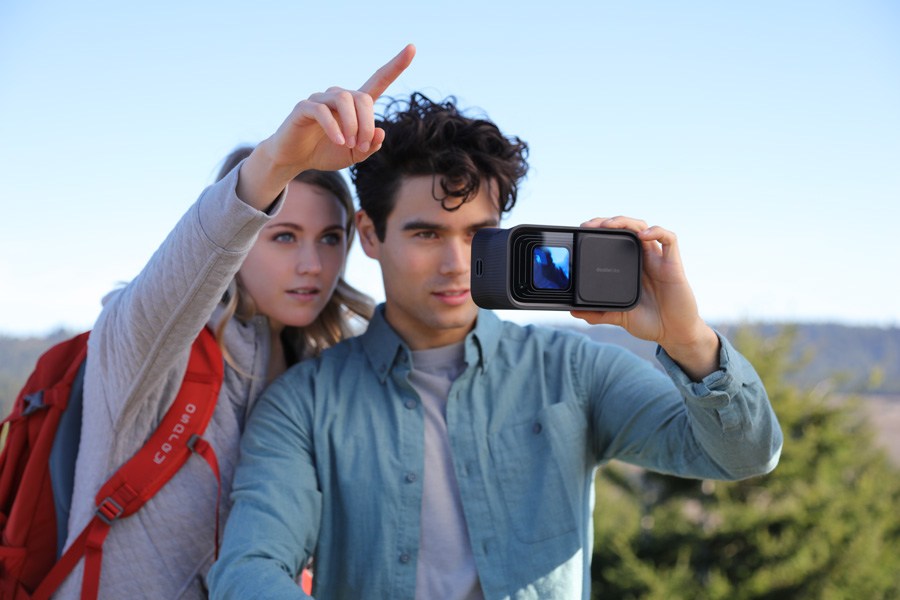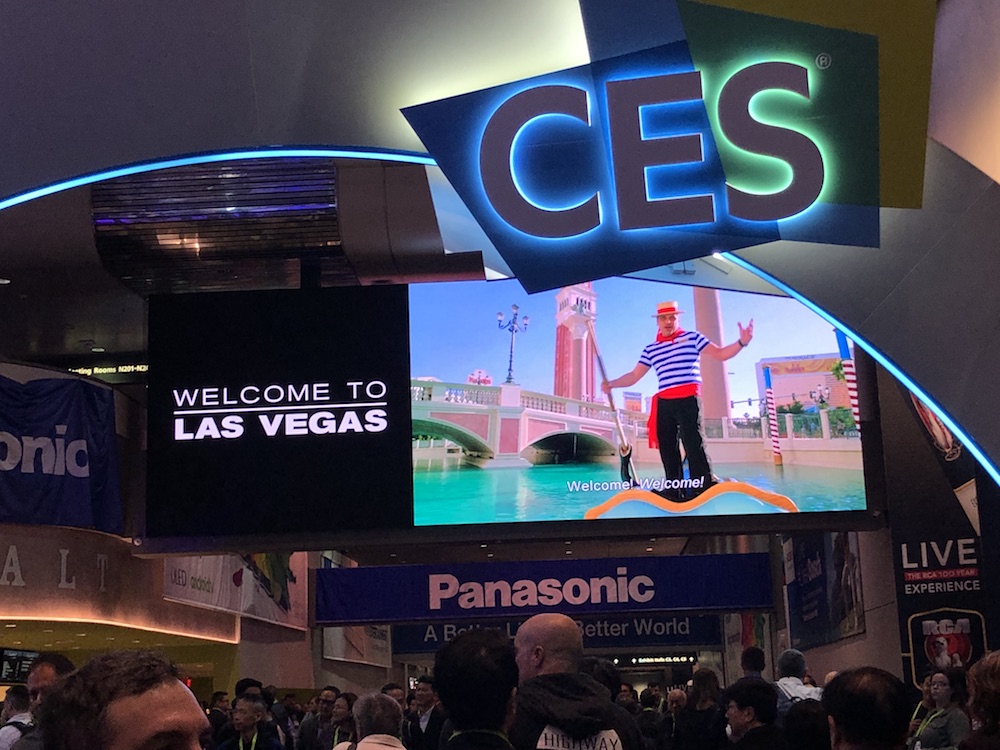What do you get when 180,000 verified geeks and 4,500 newfangled gadgets descend upon a few long blocks in Las Vegas? A lot of enhanced plastic, paper and wires and a possibly scary vision of the future at what is now fondly called CES. The Consumer Electronics show that has been happening yearly since 1967 has come a long way from the portable Motorola televisions and next gen eight-tracks that were once the siren’s song of a budding battalion of obsessed electronics fans.

Today, it is more like an ocean of FOMO enthusiasts looking at the latest in robotic capabilities, artificial intelligence and virtual reality applications, driverless vehicles, sleep tech, voice tech, sports tech … It is a formidable list of very sophisticated 3D solutions, all seeking a problem to solve. At CES2019 there were machines that baked a perfect bread and others that folded clothes, others that measure your day, shirts that communicate with other shirts, shoes that tell you where you have been, bras that regularly take measurements, water bottles that play music and other bottles that make coffee on the go.
Within the ocean of stuff, most of which will never see the inside of an Amazon order, a few gems showed through that could potentially add some spring in the step for travelers. Here is a curated vision of what CES had in mind this year for those on the road for business and pleasure.
- Hands-free suitcase. The Ovis ForwardX is part dog, part travel bag. It’s an electric case for moving around airports without having to drag your luggage along. That’s because this bag has eyes that can see you and see where it is going to keep rolling along with you without rolling into people and poles. The principles inside this truly smart [piece of luggage is technology that goes into self-driving vehicles. The 10-poung suitcase is TSA-approved and meant for carry-on purposes. It expects to sell for $800 but may still available at the 40 percent discount given to crowd-funding preorders. For those who want to turn their luggage into a skateboard, Scoocase has the solution. This battery-powered item rides like a Razor at a 15-mph clip with an aluminum suitcase built on the front to allow a balanced dash to the gate. A spot on the handle holds the smartphone and an Scoocase app helps with navigation. Great for hitting the ground running in the next destination. Rates run around $239.
- Sinus Relief in an instant. Taking a plane can wreak havoc on sinuses sensitive to changing air pressures and dry environments. ClearUP may be the answer. The palm-sized object is a holistic, over-the-counter, non-pharma answer that uses gentle microcurrents that relieve nerve tangles along acupressure points as the item makes its way around each eye and around the nasal passages. Each treatment takes around five minutes before relief ensures. The device costs around $200.
- Personal Air. In an increasingly polluted world and on increasingly more crowded flights, safe breathing can be a luxury. AirTamer is worn like a necklace and emits a constant stream of healthy negative ions to drive out pollutants, bacteria and pollen from personal breathing space and also improve athletic performance for those who jog the city streets. The item fits in the palm of the hand and creates a three-foot sphere of air around the head. It runs on two small lithium batteries and go for a full week on one charge. It costs $79.
- Find your passport. The Cube Tracker, a charm-sized blessing for your personal items, is the answer for those who tend to lose things along the way – whatever those things are and whatever way they are going. The square can be attached to wallets, passport holders, cameras, keys, files … whatever is keeping you up at night … especially while traveling when things get jostled and life gets chaotic. The Cube works with an app that can locate missing items within 100 feet, if you want them to buzz their whereabouts, or can give you the last known location of the item on a map. You can even contact another CUBE owner if that person is near your lost item. The Cube Pro is the latest edition and sells for $29.99.
- A plug for all reasons. The five- by two-inch Nomadplug is tagged the last travel adaptor you will ever buy. And that is because it is part adaptor
 and part converter without the heavy and bulky brick usually needed and with prong formats that will fit any socket anywhere. It uses a powerbank allows you to stay connected and charge your devices in any country or on the go and provides with USB and USB-C functionality. The plug usesinterlocking modules secured together with rare earth magnets and plug formats that allow connection in 190 countries. Powerful and fast charging powerbank accepts 110V – 240V sockets, 50Hz – 60Hz devices and allows for 2 USB type A and 1 USB type C connections that all can be used at the same time. The powerbank can be charged by using either the wall socket or USB port. Comes in five neon colors. Current pre-order prices on Indiegogo run $99.
and part converter without the heavy and bulky brick usually needed and with prong formats that will fit any socket anywhere. It uses a powerbank allows you to stay connected and charge your devices in any country or on the go and provides with USB and USB-C functionality. The plug usesinterlocking modules secured together with rare earth magnets and plug formats that allow connection in 190 countries. Powerful and fast charging powerbank accepts 110V – 240V sockets, 50Hz – 60Hz devices and allows for 2 USB type A and 1 USB type C connections that all can be used at the same time. The powerbank can be charged by using either the wall socket or USB port. Comes in five neon colors. Current pre-order prices on Indiegogo run $99. - Drone-style selfies. The AirSelfie is, indeed, the first portable HD aerial camera out there that was made for the selfie-crazed traveler. It looks like an atomic cocktail coaster with four small rotors on a
 plastic case that is about the size of a hand and weighs less than a wallet. It offers around six minutes of flight time. Simply remove the flying camera from the powerbank and switch it on.Open the AirSelfie app, press the lift button and watch the flying camera hover to heights up to 65 feet. Adjust height and direction with the app and let the auto-hovering take over HD aerial shots or video. Land the camera smoothly into an open hand or grab it while it’s hovering in midair. The camera has sophisticated sensors and also serves as a small hot spot. An embedded 16gb SD card stores all the photos, that can later be downloaded into a computer. Prices run around $199.95.
plastic case that is about the size of a hand and weighs less than a wallet. It offers around six minutes of flight time. Simply remove the flying camera from the powerbank and switch it on.Open the AirSelfie app, press the lift button and watch the flying camera hover to heights up to 65 feet. Adjust height and direction with the app and let the auto-hovering take over HD aerial shots or video. Land the camera smoothly into an open hand or grab it while it’s hovering in midair. The camera has sophisticated sensors and also serves as a small hot spot. An embedded 16gb SD card stores all the photos, that can later be downloaded into a computer. Prices run around $199.95. - Tablet that turns into a smartphone. While many of us do not think we need a tablet that folds down into a wallet-sized phone, Royole thinks we do and created the FlexPai. The wisdom of this device is that it is two things in one: You can read a book or watch a movie on the full-sized tablet or make a phone call from the device, that can then fit into your pocket. The secret sauce is the patented screen that can be folded and shaped and wrapped around nearly anything. The screen is virtually unbreakable and supports more than 200k bends. It cannot be cracked and is scratch proof. As with other tablets and phones, the FlexPai is also a camera with two lenses for photos and videos and improves upon the phototaking experience by letting the snapper and the subject of the photo see the pose at the same time. The OS allows for a split screen display and has a drag and drop interface. Selling price is $1500 – but you get two devices in one with that.
- Smooth talking. Everyone knows what a challenge talking can be between cultures where neither party speaks a language in common. And while translating gadgets and apps are nothing new they have been helped significantly by advancements in AI. The WT2 Plus allows is an ear to ear wearable translator for face-to-face bilingual conversations and translates languages in near real-time. It comes as two earphone translators, a charging case and an app. Parties talk and the app translates in conversational text format as well as speaks the translation into the receiving party’s ear. The software supports 36 languages and the earbuds also operate as noise reduction devices. The items start at around $99, although the price has yet to stabilize. Another translation device spied at CES2019 is the iFLYTEK Translator 2.0. It’s a sleek gadget that has its own palm-sized hardware. It translates 63 languages with advanced speech recognition capabilities and offers an instant response in text boxes on the small screen. Power users will like the professional vocabulary coverage built into the software for industries like healthcare, IT and finance. It supports communication for up to five hours at a time. The price is $450.

- FOMO-proof binos. Binoculars were always just binoculars. Until now. Nexoptic has created binoculars reimagined in the DoubleTake. They can spot game in the bush and coffee pots in distant apartments and take a movie, share a shot and capture images in ways that have even caught NASA’s attention. It runs on a patented Blade Optics lens design for improved resolution that can quickly and accurately target a movie object, push that shot to other nearby devices with internal Wi-Fi, upload that image to social media through an app, live stream it to a smartphone and record in 4k video. And it’s no bigger nor heavier than that pair of low distance binoculars that have been sitting in the bookshelf for two decades. A price has not yet been set.
- Vacation Saver. Anyone who has traveled with someone who snores knows that pain that comes in the middle of the night when you are awakened in the hotel room you are sharing by percussive tremors from your companion’s nostrils and realize you may not get a fitful night of sleep during the while trip. Long-haul flyers know the pain of settling into the midnight hours with some hope of sleep and suddenly hearing the disturbing noises from three rows down. QuietOn has taken on this challenge with a solution for a very real problem. The Finnish company created an earbud with active noise cancelling technology that is particularly effective in the lower frequencies – decibels foam earplugs do not touch. It releases a calm masking sound and nothing else. It is tiny, fits right in the ear and can be used to muffle day sounds and conversations as well. The company says it is in talks with major airlines to offer QuietOn earbuds as an amenity in upper class for long-haul flights. The sleep buds start at $159.
































































































































































































































































































Get Social